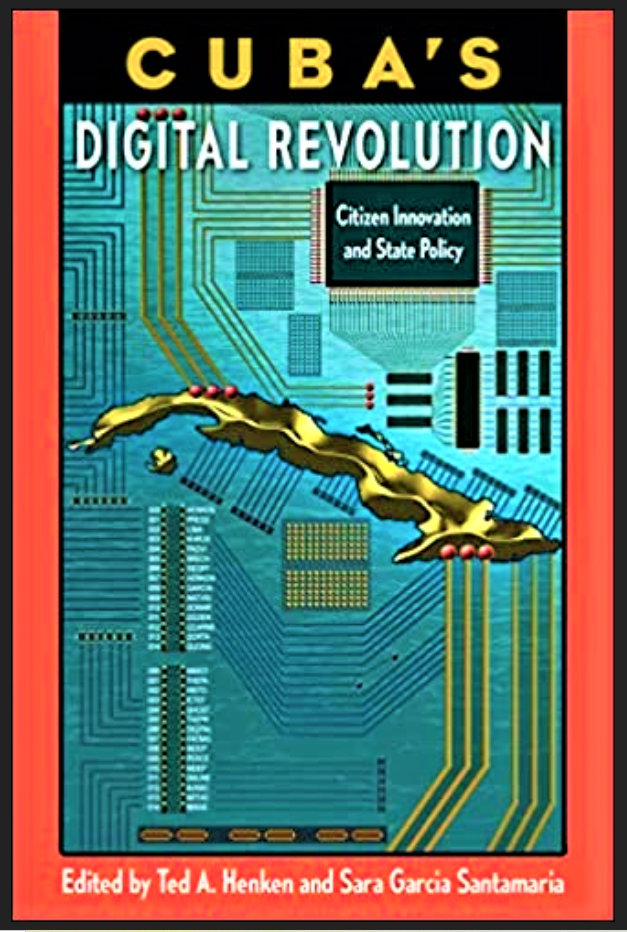A Pre-Review of CUBA’S DIGITAL REVOLUTION: CITIZEN INNOVATION AND STATE POLICY, Forthcoming, June 1, 2021, by TED A. HENKEN AND SARA GARCIA SANTAMARIA
By Larry Press Professor of Information Systems at California State University
Original Article at Larry Press’ Blog

Cuba’s Digital
Revolution: Citizen Innovation and State Policy (Reframing Media, Technology,
and Culture in Latin/o America), June 1, 2021
by Ted A. Henken and Sara Garcia Santamaria
In spite of having
a slow, expensive, government-controlled Internet infrastructure, Cuba is
undergoing what Ted Henken and Sara Garcia Santamaria refer to as a digital
revolution.
The digital
revolution might be said to have begun in 2007 when Yoani Sánchez launched her blog “Generation
Y.” Internet access was difficult — she would get illegal connectivity at
tourist hotels, and the blog was initially hosted in Germany. Soon, the
Huffington Post began publishing her posts, and she has subsequently received
many international awards, including the Ortega y Gasset Award for Digital Journalism in
2008.
I recall reading of
her teaching others to blog at her home, and other blogs followed, but that was
just the start of the digital revolution. Today, she publishes a daily digital
newspaper 14Ymedio which is available in Spanish
and English, and there are many independent (non-government) media sites that
cover fashion, sports, art, music, and technology as well as news, commentary,
and current events.
Since Cuba had and
still has very poor Internet infrastructure, one might ask how this digital content
is distributed. The digital-distribution revolution began in 2008 with el Paquete Semanal, the “weekly
package” of digital material distributed on hard and flash drives that
became a nation-wide sneakernet. El Paquete is financed by advertising and
customer fees and it has been suggested that it is the nation’s largest private
employer. In 2015, the Government began opening public-access WiFi hotspots. Cubans hackers
also created local community networks which did not have a connection to the
global Internet. The largest, Havana’s SNET, had an estimated 100,000 users before it was taken over by the government. More
recently, 3G mobile service was introduced and
now 4G is beginning to roll out.
Cuba’s independent
media and ad-hoc distribution channels are a product of a culture of innovation
— from restoring old cars and equipping bicycles with lawn-mower engines to
creating community networks like SNET, software startups, and work as
independent, self-employed programmers. Necessity is the
mother of invention.
I’ve been speaking
of media, but Henken estimates that there is also a digitally-convened movement
or protest in Cuba every two months or so. He describes several of these and
their leaders in this article.
If you are
interested in more on Cuba’s digital media revolution, check out Henken’s recent
interview at Tulane University. (It’s over an hour-long, but he
speaks clearly so you can listen at 2X speed). He talks about Cuban media and
introduces a forthcoming anthology he and Santamaria edited. In his presentation,
Henken discusses independent Cuban media and summarizes each chapter of the
book, which will be available from the University Press of
Florida on June 1.

TABLE OF CONTENTS
Introduction
In Medias Res: Who
Will Control Cuba’s Digital Revolution?, Ted A. Henken
Part I. History,
Media, and Technology
1. The Past,
Present, and Future of the Cuban Internet, Larry Press
2. Historical
Itineraries and Cyclic Trajectories: Alternative Media Communication
Technologies, and Social Change in Cuba, Edel Lima Sarmiento
Part II. Politics
3. Information and
Communication Technology, State Power, and Civil Society: Cuban Internet
Development in the Context of the Normalization of Relations with the United
States, Olga Khrustaleva
4. Ghost in the
Machine: The Incompatibility of Cuba’s State Media Monopoly with the Existence
of Independent Digital Media and the Democratization of Communication, Alexei
Padilla Herrera and Eloy Viera Cañive
5. The Press Model
in Cuba: Between Ideological Hegemony and the Reinvention of Civic Journalism,
Carlos Manuel Rodríguez Arechavaleta
6. Digital Critique
in Cuba, Marie Laure Geoffray
Part III.
Journalism
7. From Generación
Y to 14ymedio: Beyond the Blog on Cuba’s Digital Frontier, Ted A. Henken
8. Independent
Journalism in Cuba: Between Fantasy and the Ontological Rupture, Sara Garcia
Santamaria
9. Perceptions of
and Strategies for Autonomy among Journalists Working for Cuban State Media,
Anne Natvig
10. Independent
Media on the Margins: Two Cases of Journalistic Professionalization in Cuba’s
Digital Media Ecosystem, Abel Somohano Fernández and Mireya Márquez-Ramírez
Part IV. Business
and Economy
11. Online
Marketing of Touristic Cuba: Branding a “Tech-Free” Destination,
Rebecca Ogden
12. A Una Cuba
Alternativa”? Digital Millennials, Social Influencing, and Cuentapropismo
in Havana, Jennifer Cearns
Part V. Culture and
Society
13. Without
Initiation Ceremonies: Cuban Literary and Cultural E-zines, 2000 — 2010,
Walfrido Dorta
14. Images of
Ourselves: Cuban Mediascapes and the Post-socialist “Woman of
Fashion,” Paloma Duong

Sara García Santamaría
Blanquerna – Universitat Ramon Llull (Spain)

Ted
Henken
Baruch
College, City University of New York.



Comments
Comments for this post are closed.